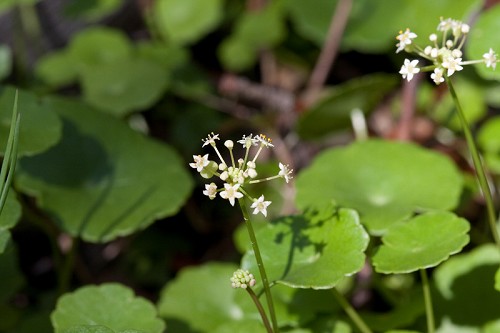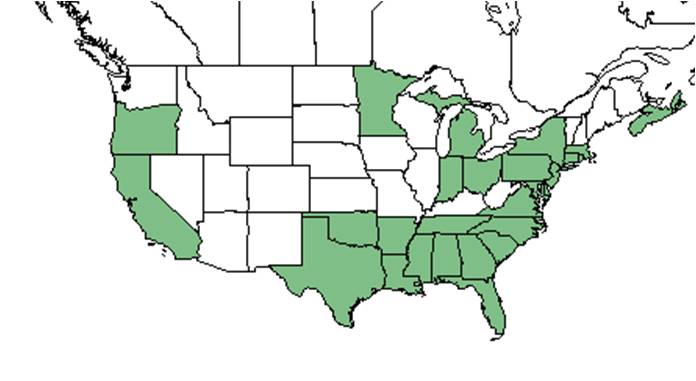Hydrocotyle umbellata
| Hydrocotyle umbellata | |
|---|---|

| |
| Photo by John R. Gwaltney, Southeastern Flora.com | |
| Scientific classification | |
| Kingdom: | Plantae |
| Division: | Magnoliophyta - Flowering plants |
| Class: | Magnoliopsida - Dicotyledons |
| Order: | Apiales |
| Family: | Apiaceae ⁄ Umbelliferae |
| Genus: | Hydrocotyle |
| Species: | H. umbellata |
| Binomial name | |
| Hydrocotyle umbellata L. | |

| |
| Natural range of Hydrocotyle umbellata from USDA NRCS Plants Database. | |
Common name: manyflower marshpennywort
Contents
Description
Hydrocotyle umbellata is a perennial terrestrial and aquatic species. The umbrella shaped leaves will dominate groundcover for moist soils or submerged shallow water [1]. The leaves are peltate with veins radiating from the point of the petiole and the blades rounded with heavily notched margins [2]. The star-shaped flowers are small with seperate petals and sepals and five stamen[3].
It is distinguishable from Hydrocotyle ranunculoides by having a light green disk at the location of petiole attachment while H. ranunculoides has a light pink disk [2].
"Glabrous perennials, rooting from the nodes of the prostrate, creeping or floating stems. Leaves solitary at the nodes, simple, peltate or cordate, orbicular to reniform, blades entire, lobed, or crenate; petioles nonsheathing. Umbels simple, branched, or verticillate; involcure much reduced or absent; flowers few or many, petals white or greenish. Fruit strongly flattened laterally, glabrous, 1-2 mm long. Carpophores absent; mericarps narrowly ovate in cross section." - Radford et al 1964
"Leaves peltate, orbicular, 1-4 cm wide, crenate; petioles 4-15 (25) cm long. Umbels simple, of 15-50 pedicellate flowers, 1-2 cm broad, peduncle equaling or, more often, exceeding the length of the petioles." - Radford et al 1964
Distribution
Occurs from south America throughout central America and the Caribbean and along the Atlantic coast[4].
Ecology
Habitat
H. umbellata is both a terrestrial and aquatic species being found in areas such as swamps, lake shores, shallow water of pond pine flats, sandy peaty ditches, shallow water of flowing streams, moist sands of open flatwoods,and floodplains. It occurs in disturbed areas such as moist roadside ditches, man made ponds, wet pastures, levees, and drainage ditches. Associated species include Eryngium prostratum, Ludwigia arcuata, Panicum hemitomon, and Bacopa (FSU Herbarium).
Growth rate in terrestrial environments is double the growth rate in aquatic environments. The leaves produced in terrestrial environments differ significantly in the structure and morphology from aquatic leaves and cannot acclimate to aquatic conditions, resulting in death. In aquatic conditions, it has been observed to have an increased petiole length and larger leaves with more stomata on the upper than on the lower surface (Reekie and Dawe 2007).
Phenology
The star shaped flowers are small and terminate in umbels[2]. It reproduces both sexually by seed and vegetatively by growth and fragmentation of rhizomes; however, reproduce primarily by asexual reproduction (Vasseur 2005). It can be seen flowering and fruiting March through December (FSU Herbarium).
Seed bank and germination
Germination rate is higher in flooded conditions than in moist soil conditions (Wetzel et al. 2001).
Pollination
The following Hymenoptera families and species were observed visiting flowers of Hydrocotyle umbellata at Archbold Biological Station (Deyrup 2015):
Halictidae: Halictus poeyi
Pompilidae: Episyron conterminus posterus
Sphecidae: Cerceris blakei, Ectemnius rufipes ais, Epinysson mellipes, Hoplisoides denticulatus denticulatus, Oxybelus emarginatus, Tachysphex apicalis, T. similis
Vespidae: Leptochilus alcolhuus, Parancistrocerus salcularis rufulus
Cultivation and restoration
It has often been used in folk medicine to treat skin ulcers and rheumatism (Florentino et al. 2013).
Photo Gallery
References and notes
Deyrup, M.A. and N.D. 2015. Database of observations of Hymenoptera visitations to flowers of plants on Archbold Biological Station, Florida, USA.
Florentino, I. F., M. V. M. Nascimento, et al. (2013). "Evaluation of analgesic and anti-inflammatory activities of Hydrocotyle umbellata L., Araliaceae (acaricoba) in mice." Anais Da Academia Brasileira De Ciencias 85(3): 987-997.
Florida State University Robert K. Godfrey Herbarium database. URL: http://herbarium.bio.fsu.edu. Last accessed: October 2015. Collectors: Loran C. Anderson, Mel Boreham, J.P. Gillespie, Robert K. Godfrey, D.C. Hunt, Gary R. Knight, R. Komarek, R. Kral, H. Kurz, R.L. Lazor, William Lindsey, Sidney McDaniel, Herbert Monoson, William Platt, R.A. Pursell, Gwynn W. Ramsey, P.L. Redfearn Jr., J. Sincock, Cecil R. Slaughter, H. Larry Stripling, Victoria Sullivan. States and Counties: Florida: Bradford, Brevard, Citrus, Franklin,Gad Hernando, Jackson, Jefferson, Leon, Levy, Liberty, Madison, Martin, Nassau, Okaloosa, Orange, Pinellas, Putnam, Sumter, Taylor, Wakulla, Walton. Georgia: Thomas. Countries: Costa Rica, Panama. Compiled by Tall Timbers Research Station and Land Conservancy.
Radford, Albert E., Harry E. Ahles, and C. Ritchie Bell. Manual of the Vascular Flora of the Carolinas. 1964, 1968. The University of North Carolina Press. 763-4. Print.
Reekie, E. G. and C. E. Dawe (2007). "The effects of flooding regime on the rare Atlantic coastal plain species Hydrocoytle umbellata." Canadian Journal of Botany 85(2): 167-174.
Wetzel, P., A. van der Valk, et al. (2001). "Restoration of wetland vegetation on the Kissimmee River Floodplain: Potential role of seed banks." Wetlands 21(2): 189-198.
- ↑ [Wildflower]Accessed December 14, 2015
- ↑ 2.0 2.1 2.2 [Clemson Cooperative Extension]Accessed: December 18, 2015
- ↑ [Go Botany]Accessed: December 17, 2015
- ↑ [Cosewic Assessment and Status Report] Accessed: December 17, 2015